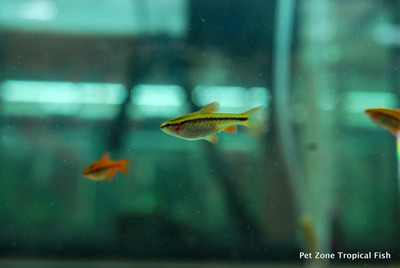Cherry Barb: A Delightful Splash of Color for Your Aquarium
Posted by Max Gandara on on 14th May 2024
Cherry Barb: A Delightful Splash of Color for Your Aquarium
Aquarium enthusiasts often seek vibrant and lively additions to their tanks, and the Cherry Barb (Puntius titteya) is a perennial favorite. With its striking coloration, peaceful temperament, and manageable care requirements, this small freshwater fish offers both beauty and ease to aquarists of all levels. Let’s dive into the world of the Cherry Barb and explore why it makes such a wonderful choice for your home aquarium.
A Burst of Color
The Cherry Barb is named for its cherry-red hue, which is especially pronounced in males. Males display a vivid, deep red coloration, while females tend to be more subdued with a light pink or brownish tint. This dimorphism makes it easy to distinguish between the sexes, adding an interesting dynamic to their behavior and interactions within the tank.
Natural Habitat
Originally hailing from the slow-moving, shaded streams and rivers of Sri Lanka, Cherry Barbs have adapted well to a variety of conditions. Their natural environment is typically dense with vegetation, providing ample hiding spots and foraging opportunities. Recreating this environment in your aquarium not only keeps them healthy but also brings out their best colors and natural behaviors.
Aquarium Setup
Tank Size: Despite their small size (reaching about 2 inches in length), Cherry Barbs thrive best in tanks of at least 20 gallons. This gives them ample swimming space and allows for the creation of a comfortable, naturalistic environment.
Water Conditions: Cherry Barbs are hardy and adaptable but prefer slightly acidic to neutral pH levels (6.0-7.0) and soft to moderately hard water. The ideal temperature range is between 73°F and 81°F (23°C to 27°C).
Décor and Plants: To mimic their natural habitat, use a variety of plants, driftwood, and rocks. Plants like Java fern, Anubias, and various Cryptocoryne species are excellent choices. A dark substrate can enhance their coloration and create a more aesthetically pleasing environment.
Filtration and Maintenance: A gentle filter is recommended to maintain water quality without creating too much current, which can stress these small fish. Regular water changes (about 25% weekly) help keep the environment clean and healthy.
Social Behavior and Tank Mates
Cherry Barbs are peaceful and social fish, making them ideal for community tanks. They should be kept in schools of at least six to encourage natural schooling behavior and reduce stress. Males may display mild aggression during breeding periods, but this is typically harmless and short-lived.
When selecting tank mates, opt for other peaceful species. Good companions include small tetras, rasboras, Corydoras catfish, and other non-aggressive barbs. Avoid larger, more aggressive fish that might bully or outcompete them.
Feeding
Omnivorous by nature, Cherry Barbs enjoy a varied diet. High-quality flake food, micro-pellets, and frozen or live foods like brine shrimp, daphnia, and bloodworms ensure they receive the necessary nutrients. Supplementing their diet with blanched vegetables like zucchini or spinach can also be beneficial.
Breeding Cherry Barbs
Breeding Cherry Barbs is relatively straightforward, making them a popular choice for aquarists interested in breeding fish. To encourage spawning, provide a well-planted breeding tank with slightly warmer water (around 78°F or 25°C). Males will display brighter colors to attract females, who will scatter eggs among the plants. Remove the adults after spawning to prevent them from eating the eggs. The fry will hatch in about 24-48 hours and can be fed infusoria or commercially prepared fry foods until they are large enough to eat larger foods.
Health and Disease
Cherry Barbs are generally hardy, but like all aquarium fish, they can be susceptible to diseases such as ich, fin rot, and bacterial infections. Maintaining good water quality, providing a balanced diet, and observing your fish regularly for any signs of illness are key to keeping them healthy. Quarantining new additions before introducing them to the main tank can prevent the spread of diseases.
Conclusion
The Cherry Barb is a stunning and rewarding addition to any freshwater aquarium. Its brilliant coloration, peaceful nature, and ease of care make it a perfect choice for both novice and experienced aquarists. By providing a well-maintained environment that mimics their natural habitat, you can enjoy the vibrant presence of Cherry Barbs and contribute to their well-being. Whether you’re looking to add a splash of color to your tank or interested in breeding, the Cherry Barb offers a delightful and engaging aquarium experience.

